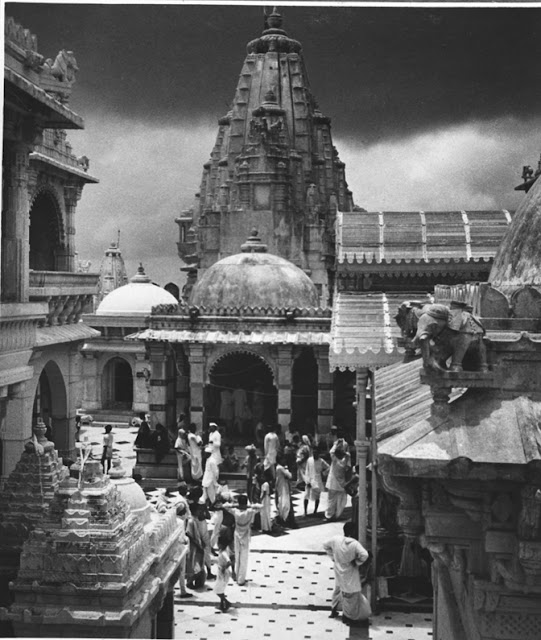 |
| 11th century Group of Jain Temples, Palitana, Satrunjaya Mountain, Gujarat (1949) |
11th century Group of Jain Temples, Palitana, Satrunjaya Mountain,
Gujarat, Palitana was a princely state of India till it merged with India after
independence in August 1947. It was the capital of the Kingdom of Rajpipla and
Gohil Rajput clan. Rishabha sanctified the hill where he delivered his first sermon. It was
his grandson Pundarik, grandson of Rishabha who received salvation at
Shatrunjay, hence the hill was originally known as "Pundarikgiri".
Bharata, the father of Pundarik and half-brother of Bahubali, also came to
Shatrunjaya many times; he is also credited with building a temple here.
History
 |
| 11th century Group of Jain Temples, Palitana, Satrunjaya Mountain, Gujarat |
The Palitana temples were built over a period of 900 years starting in
the 11th century. They were destroyed by Turkish Muslims invaders in 1311 AD,
when the saint Jinaprabhasuri, who was then 50 years old, presided over the
temples. Two years later, the rebuilding began. While some temple building activity
took place under Samara Shah, it was only two centuries later that it picked up
momentum, when in 1593, Hiravijayasuri (Chief of Tapa Gaccha) organized a major
pilgrimage to this location to attend the consecration ceremony of the temple
built for Rishabha by Tej Pal Soni, a merchant. Following this, there was
proliferation of temples here.
.jpg) |
| 11th century Group of Jain Temples, Palitana, Satrunjaya Mountain, Gujarat |
The most important temples are those of Adinath, Kumarpal, Sampratiraja,
Vimal Shah, Sahasrakuta, Ashtapada and Chaumukh. Some of them are named after
the wealthy patrons who paid for the construction. Most of them which are now
present date to the 16th century. In 1656, Shah Jahan's son Murad Baksh (the
then Governor of Gujarat) granted Palitana villages to the prominent Jain
merchant Shantidas Jhaveri, a Svetambara Jain, in 1656, and subsequently when
all taxes were also exempted that the temple town further prospered. It was
brought under the control of the Kalyanji Anandji Trust in 1730 to manage not
only Palitana temples but also many other temples of Svetambara Jains, since
the Mughal period.
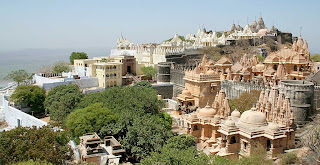 |
| 11th century Group of Jain Temples, Palitana, Satrunjaya Mountain, Gujarat |
It is said that sculptors' skills and capacity to carve with abrasive
chords (not tools) the intricate designs was paid on the basis of the marble
dust that they had collected every evening after their hard labour. Kumarpal
Solanki, a great Jain patron, probably built the earliest temples.[citation
needed]
History also make a mention that Lunia Seth Tilokchand, a merchant from
Ajmer led a very large contingent of pilgrims to the Shatrunjaya temples when
he heard that there were some disturbances at the Angarshah Pir on the hills.
But he continued his pilgrimage and pleased the Pir by his offerings. This
tradition is followed to this day by his descendents by offering an expensive
cloth to cover the dome of the shrine.
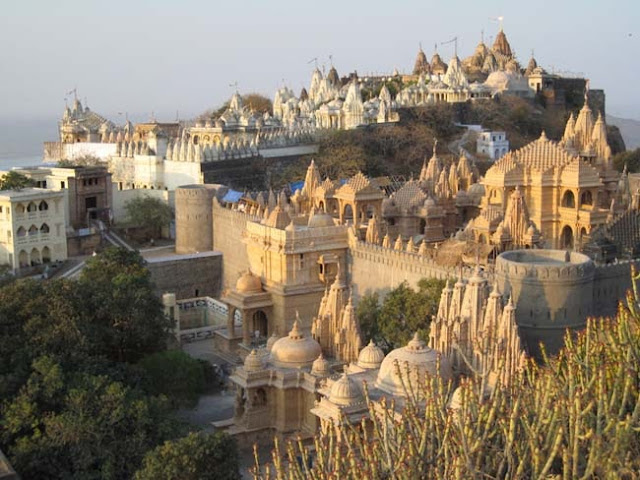 |
| 11th century Group of Jain Temples, Palitana, Satrunjaya Mountain, Gujarat |
Many of these temples are kept in “mint” condition with large donations
provided by the rich Jain merchant community.
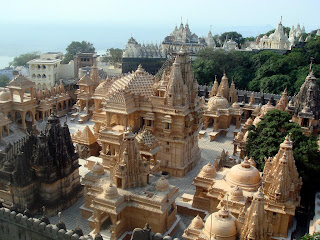 |
| 11th century Group of Jain Temples, Palitana, Satrunjaya Mountain, Gujarat |
The Palitana temples of Jainism are located on Mount Shatrunjaya, by the
city of Palitana, in Bhavnagar district, Gujarat, India. The city of the same
name, known previously as Padliptapur, has been nicknamed "City of
Temples". Along with Sammet Shikhar, earlier in Bihar state, now of
Jharkhand, the two sites are considered the holiest of all pilgrimage places by
the Jain community. As the temple-city was built to be an abode for the divine,
no one is allowed to stay overnight, including the priests. Every Jain believes
that a visit to this group of temples is essential once in a life time to
achieve nirvana or salvation.
The Jain's sacred site of Shatrunjay contains hundreds of Palitana
temples. There are approximately 863 marble-carved temples on the hills. It is
said that 23 Tirthankara (a human being who helps in achieving liberation and
enlightenment), except Neminath (a liberated soul which has destroyed all of
its karma), sanctified the hill temples by their visits. The main temple is
dedicated to the Rishabha, the first Tirthankara; it is the holiest shrine for
the Svetambara Murtipujaka Jain sect who are worshipers of images of gods. The
Digambara sect of Jainism has only one temple here.
Geography
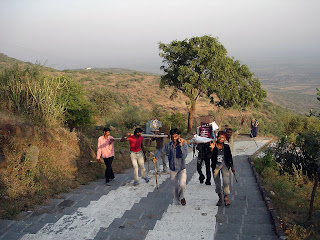 |
| 11th century Group of Jain Temples, Palitana, Satrunjaya Mountain, Gujarat |
Palitana viewed from
Satrunjaya Hill
The Gulf of Cambay is to the south of the Shatrunjaya Hills, and
Bhavanagar town is to the north of the hills with the Shetrunji River flowing
in between. Palitana, a city in the Bhavnagar district of Gujarat, is 2
kilometres (1.2 mi) away. The Palitana Temples are situated at the twin summits
and the saddle linking them. The temple complex is located 56 kilometres (35
mi) southwest of Bhavnagar, a major pilgrimage centre for Jains. The summit is
situated at an elevation of 7,288 feet (2,221 m). Reaching it involves climbing
over 3,750 stone steps. However, during the monsoon season the temples are
closed for devotees.
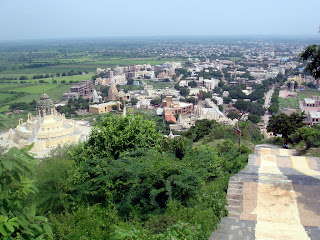 |
| 11th century Group of Jain Temples, Palitana, Satrunjaya Mountain, Gujarat |
Paths
It takes approximately two hours to make the 3.5 kilometres (2.2 mi)
climb. There are multiple routes. The shortest one goes around the outer walls
of the temples on the hilltop and passes Angar Pir, the shrine of a Muslim
saint who is reported to have protected the temples on during Muslim invasions.
A second route goes around the foot of the mountain. A large number of pilgrims
take part in a third route in the month of Phalguna (February/March), which
passes five sacred temple sites over a distance of 45 kilometres (28 mi).
Elderly pilgrims who cannot climb the stairs are carried on a doli (swing
chair) carried by porters and charged based on the pilgrim's weight.
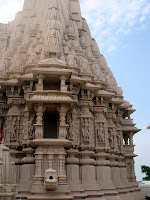 |
| 11th century Group of Jain Temples, Palitana, Satrunjaya Mountain, Gujarat |
Grounds
From the top of Shatrunjaya are views of the Gulf of Cambay and the
rugged, drought-affected landscape. The narrow streets or lanes in the temple
complex are similar to the ones found in the medieval cities of Europe. The
high walls surrounding the temples give the appearance of a fort. Important
features include the Ashok tree, the Chaitra tree, Jaytaleti, four-mouthed idol
of Bhagawan Mahavir, Hingraj Ambikadevi (known as Hinglaj Mata, the presiding
deity of the hill), Kumarpal, Vimalshah and Samprati.
One favor? Would you
throw a link somewhere back to ttp://vedictemplesin.blogspot.com? Pretty
please? Thanks
















0 comments:
Post a Comment